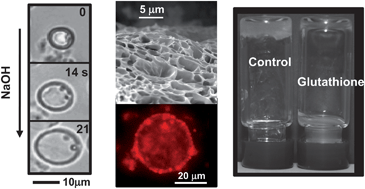Tuning the properties of pH-responsive and redox sensitive hollow particles and gels using copolymer composition
Abstract
Biodegradable pH-responsive hollow

* Corresponding authors
a Biomaterials Research Group, The School of Materials, The University of Manchester, Grosvenor Street, UK
b Tissue Injury and Repair Group, School of Medicine, Stopford Building, The University of Manchester, Oxford Road, Manchester, UK
Biodegradable pH-responsive hollow

 Please wait while we load your content...
Something went wrong. Try again?
Please wait while we load your content...
Something went wrong. Try again?
R. Bird, T. Freemont and B. R. Saunders, Soft Matter, 2012, 8, 1047 DOI: 10.1039/C1SM06507F
To request permission to reproduce material from this article, please go to the Copyright Clearance Center request page.
If you are an author contributing to an RSC publication, you do not need to request permission provided correct acknowledgement is given.
If you are the author of this article, you do not need to request permission to reproduce figures and diagrams provided correct acknowledgement is given. If you want to reproduce the whole article in a third-party publication (excluding your thesis/dissertation for which permission is not required) please go to the Copyright Clearance Center request page.
Read more about how to correctly acknowledge RSC content.
 Fetching data from CrossRef.
Fetching data from CrossRef.
This may take some time to load.
Loading related content
